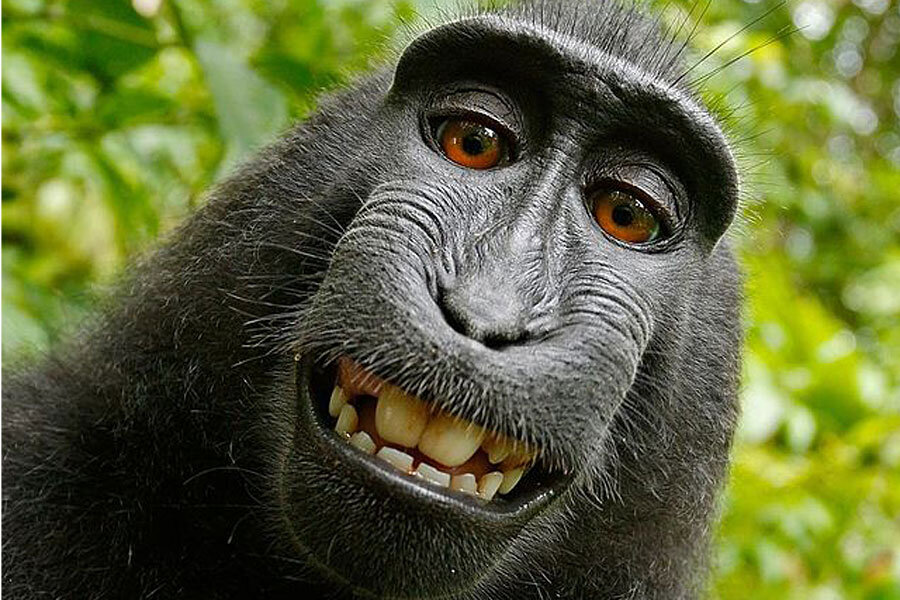US government: Monkey selfies ineligible for copyright
No matter if its quality matches that of an Ansel Adams or a Dorothea Lange, it turns out a photograph taken by a nonhuman animal is not eligible for copyright.
Marking an end to the controversy surrounding the "monkey selfie," a self-portrait snapped by a particularly photogenic macaque in Indonesia in 2011, the US Copyright Office noted on Tuesday in a public draft of the Compendium of US Copyright Office Practices, Third Edition, that to be eligible to register an original work of intellectual property – be it a patent, trademark, or trade secrets – one must be a living, breathing, Homo sapiens.
"The US Copyright Office will register an original work of authorship, provided that the work was created by a human being," the rules state, adding that "the Office will not register works produced by nature, animals, or plants."
More to the point, in a list of examples of the type of work that cannot be copyrighted, the Office lists a "photograph taken by a monkey," in addition to a "mural painted by an elephant" and a "claim based on driftwood that has been shaped and smoothed by the ocean."
Moreover, the Copyright Office points out that neither ghosts nor spirits may copyright their work.
"Likewise, the Office cannot register a work purportedly created by divine or supernatural beings, although the Office may register a work where the application or the deposit copy(ies) state that the work was inspired by a divine spirit."
But these rules are not new. The US Copyright Office has never in fact granted copyright to a work of authorship composed by a non-human actor. Rather, it has always granted copyright exclusively to humans. The difference now, however, is that the Copyright Office has decided to spell out explicitly this aspect of the law in order to quell fuss over the monkey photo, according to Jessica Litman, a Law Professor at the University of Michigan who specializes in Intellectual Property.
"This is an explanation for the public of all the rules the copyright office itself follows when it's registering or examining works," Ms. Litman says, adding that she knows of no country that grants copyright to a work not made by a human. "It's an explanation of how the Copyright Office has been interpreting the law for some time."
This debate stems from an excursion taken by British photographer David Slater to Indonesia in 2011. On the trip, Mr. Slater set up his photography equipment to snap photos of the Celebes crested black macaques, a critically endangered species that lives primarily on the Indonesian island of Sulawesi. The creatures are notable for their long, hairless faces, the cluster of hair perched atop their heads, and their big, bulging eyes.
For Slater, one of these monkeys would create a lasting impression. A female macaque grabbed one of his cameras and proceeded to repeatedly hit the shutter button, resulting in photos of herself, otherwise known as "selfies."
Apparently, even endangered species' of monkeys have the photo-snapping penchant so often used to characterize the young (human) members of the Millennial generation.
Yet this type of behavior is not out of the ordinary for macaques, which are naturally inquisitive about the world, according to Nancy Hawkes, general curator of the Woodland Park Zoo in Seattle, Wash. that houses lion-tailed macaques
"Macaques are intelligent, curious creatures," Ms. Hawkes said in an interview with Mashable earlier this month. "It's no surprise to us that an inquisitive individual went to investigate this strange, new object in front of her ... Keeping things new, interesting and challenging is very rewarding for primates, and we see the same instincts at play in this macaque's interest in the camera."
But, though the photo was taken three years ago, it has been causing quite a commotion lately. That's because someone recently uploaded one of the photos taken by the Macaque to Wikimedia Commons, an online database of free images owned by the Wikipedia Foundation. The image was subsequently added to the Celebes crested macaque Wikipedia page. When Slater discovered this, he requested the image be taken down, citing the loss of royalties from people using the image for free.
Slater says while the monkey may have technically pressed the button that created the photo, most of the work behind the image was done by him.
"You could look at it like this, the monkey was my assistant," Slater said in a recent interview with the BBC. "And, therefore, I was the artist behind the image and I allowed my assistant to press the button."
And yet, at least in the US, that's just not enough.
"No human author has rights to a photograph taken by a monkey," says Lipman, the University of Michigan Law Professor. Though she says Slater could make the argument that he owns the rights to a version of the photo if he were to heavily redesign it in the photo-editing process, the original work is not his.
"The original monkey selfie is in the public domain," Lipman says.






